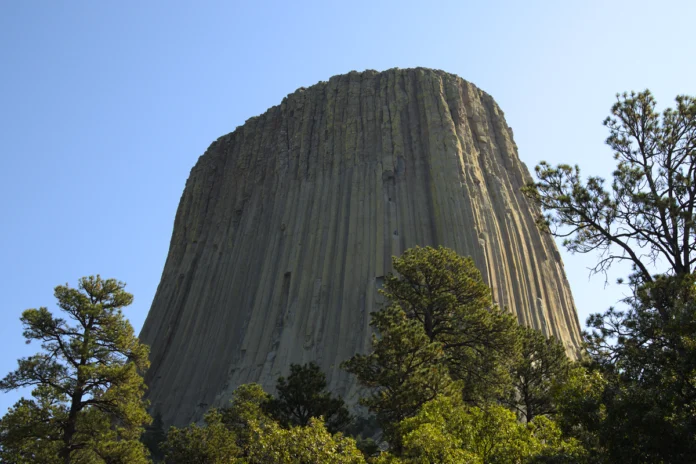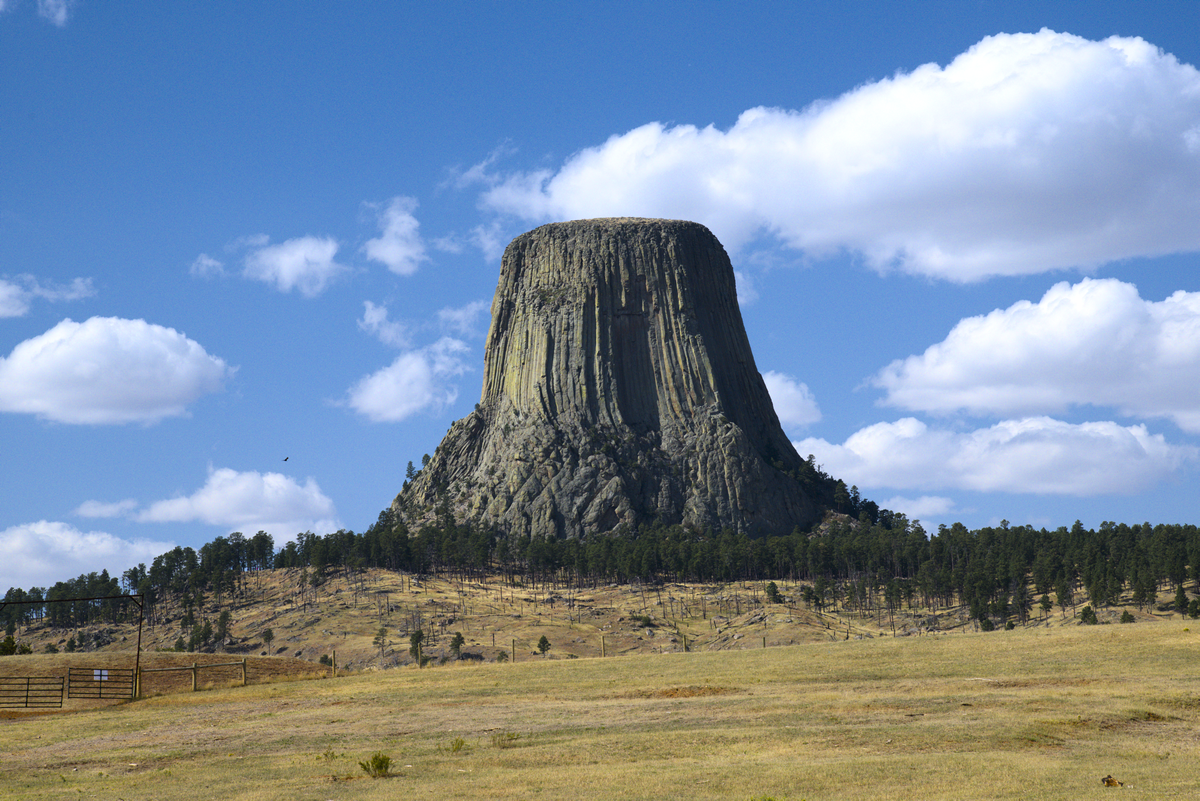Long before it became a national monument, Devils Tower held profound spiritual significance for the Indigenous peoples of the region. Several tribes, including the Lakota, Cheyenne, Kiowa, and Crow, share legends surrounding the tower’s origin, with a common thread: a tale of children saved by the great spirits.
The Lakota story tells of seven young girls chased by giant bears. As the bears closed in, the Great Spirit lifted the girls skyward, and their desperate claws left deep grooves on the tower’s sides as the rock rose from the earth. These claw marks remain etched into the stone to this day, a testament to the sacred protection and the raw power of nature.
For Native Americans, Devils Tower is not just a natural wonder but a sacred site—a place of prayer, vision quests, and ceremonies. Respect and reverence here aren’t optional; they’re essential.
Geology: The Birth of a Tower
Devils Tower’s imposing columns rise 867 feet from the surrounding terrain, crowned at 5,112 feet above sea level. Geologists agree it’s an igneous intrusion — a hardened magma plug pushed upward through sedimentary rock millions of years ago.
The tower’s distinct columnar jointing, resembling giant hexagonal pillars stacked like basalt fingers, forms as the molten rock cooled and contracted. Wind and water gradually eroded the softer surrounding sedimentary rock, revealing the tower we see today.
Its geology is a textbook example of volcanic neck formation, but don’t let the science strip the awe away. This place is a raw monument to earth’s ancient forces, silently standing guard on the plains.
Hollywood Spotlight: Close Encounters of the Third Kind
Devils Tower leapt from the pages of geology and legend into cinematic fame with Steven Spielberg’s 1977 film Close Encounters of the Third Kind. The movie immortalized the tower as the mysterious meeting place between humans and extraterrestrials.
While the film took liberties with the tower’s purpose, it undeniably put this remote Wyoming landmark on the global map. Fans and tourists have flocked here ever since, drawn by the allure of UFOs and the promise of something greater beyond the stars.
| VISITING DEVILS TOWER
Summer:
Summers at Devils Tower bring long, warm days perfect for exploration. Temperatures typically hover between the mid-70s and mid-80s Fahrenheit, making it comfortable for hiking the Tower Trail, a 1.3-mile loop that circles the base. The skies are usually clear, ideal for climbing or photography.
This is peak season, so expect crowds, especially on weekends and holidays. The visitor center is fully staffed, offering ranger talks, exhibits, and information about the tower’s natural and cultural history. Nearby campgrounds and lodging fill up fast, so booking ahead is a must.
Summer is also when Native American ceremonies take place. Visitors are asked to be respectful, especially when access to climbing routes is temporarily restricted during prayer gatherings.
Winter:
Winter at Devils Tower is a stark contrast—quiet, cold, and far less crowded. Temperatures often drop below freezing, with snow blanketing the landscape and creating a serene, almost otherworldly atmosphere.
The trails can be icy or snow-covered, requiring good boots and caution. Many facilities reduce hours or close for the season, so it’s essential to plan accordingly. But for those who brave the cold, winter offers a rare chance to experience the tower in solitude, with the silence of the plains broken only by the wind.
Wildlife sightings can be more frequent, and the clear winter skies provide excellent stargazing opportunities far from city lights.
Today’s Tourism: Respectful Exploration
Today, Devils Tower is a National Monument managed by the U.S. National Park Service, welcoming over half a million visitors each year. Hiking trails offer panoramic views of the tower and the surrounding Black Hills, while climbing routes challenge adventurers eager to scale its sheer walls.
But it’s not all about adrenaline. The National Park Service works closely with local tribes to protect the site’s sacredness, encouraging visitors to honor traditional closures—especially during peak ceremonial times in June.
The visitor center provides educational exhibits on the tower’s geology, history, and cultural significance, grounding tourism in awareness rather than mere spectacle.
Standing the Test of Time
Devils Tower is more than a rock formation. It’s a bridge across cultures and centuries—a testament to the power of nature, the endurance of native traditions, and the lure of the unknown. Whether you come for the legend, the science, the history, or the chance to stand in a place where the earth and sky seem to meet, Devils Tower demands respect and rewards those willing to listen.
| MORE HISTORY
Naming Controversy:
The name “Devils Tower” is believed to have come from a mistranslation or misunderstanding of Native American terms. Some attribute it to Colonel Dodge’s 1875 report, where “Bad God’s Tower” was mistakenly recorded as “Devils Tower.” The name stuck despite controversy and calls for restoration of indigenous names.
National Monument Designation:
President Theodore Roosevelt proclaimed Devils Tower the first U.S. National Monument on September 24, 1906, under the Antiquities Act. This early protection set a precedent for preserving natural and cultural landmarks across the country.
Tourism and Climbing History:
Devils Tower quickly became a destination for tourists and climbers. The first recorded technical ascent was in 1893 by William Rogers and Willard Ripley, using wooden pegs hammered into cracks. Today, it remains a premier climbing spot, with hundreds of routes, but climbing is voluntarily closed in June to respect Native American ceremonies.
REFERENCES & MORE INFORMATION
- National Park Service: Devils Tower National Monument
- The Legend of Devils Tower – Lakota Times
- Geology of Devils Tower – Geology.com
- History of Devils Tower in *Close Encounters of the Third Kind* – History.com
- Devils Tower Native American Legends – OnlyInYourState
- Visiting Devils Tower – Wyoming Tourism






